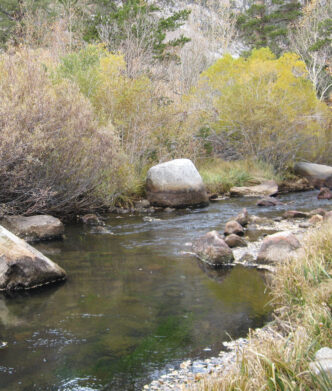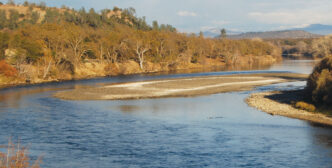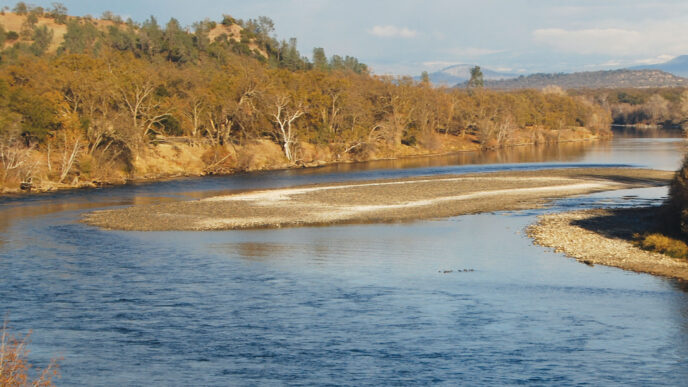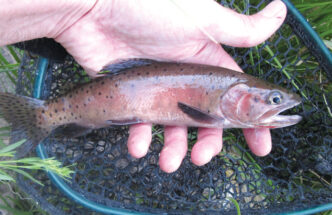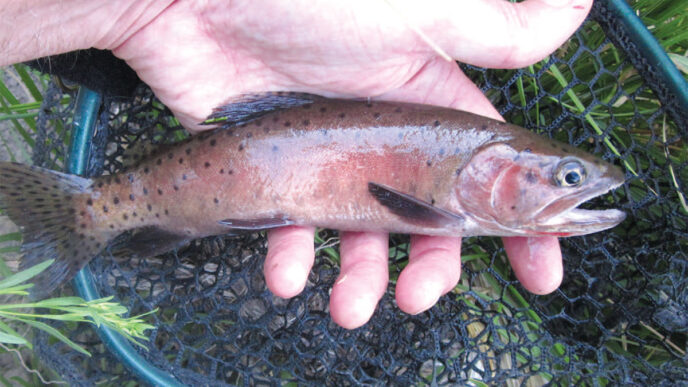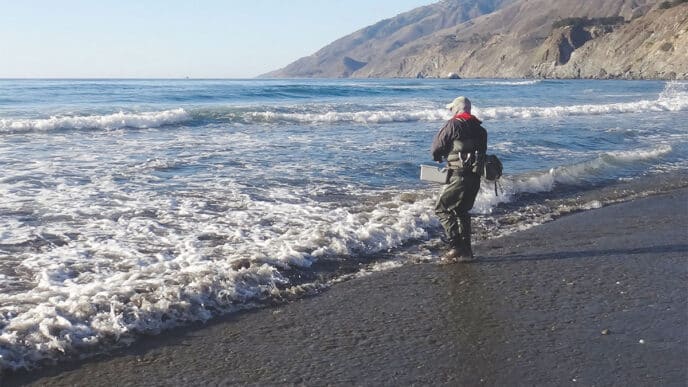The adage that variety is the spice of life certainly applies to trout fishing in the eastern Sierra. Every time you step out the door, you have your pick of hundreds of opportunities that include the sage meadows of the West Walker River or Long Valley, the tumbling pockets and pools of the Middle Fork of the San Joaquin, the intimate little tributaries of the John Muir or Ansel Adams Wilderness, the haunts of California’s state fish, the golden trout, or the possibility of something truly big from the East Walker or Hot Creek. I try to sample from this menu as widely as possible. I have probably fished more than two hundred locations on the east side and have amassed a wealth of memorable experiences as a result.
However, there is a downside to being a generalist. Part of the reason why guides are able to put people on fish consistently is because they are on the water daily and can evaluate the immediate conditions using a fund of knowledge built up over multiple seasons. Fishing many locations, perhaps only once every year or so, forfeits the opportunity to get to know any single place well. It is a process of fishing at random, hoping to hit a spot at a time when the conditions match your hopes and expectations. Sometimes you knowingly take a chance on a new location, just to see what is there. By and large, though, the selection of a destination is not based on what is known about that place on this particular day, but arrived at by thumbing through recollections of the past. The recollection could be a single fall brown trout from the Owens River (not a helpful focus in May), a well-made cast to a difficult lie, or just general memories of fishing Rock Creek amid the colors of fall. The point is that the choice is not made on the basis of what is currently going on at the stream, but what you believe went on in the past.
This past year, I undertook an experiment in which I would fish a specific location on a weekly basis. I chose the South and Middle Forks of Bishop Creek because they are close to my house, and I have always enjoyed my time on each. Plus, having fished them once or twice a year for 15 years, I thought I knew how to fish the water. On this score, I was in for a surprise. I limited myself to a couple of stretches on each stream and visited one or both 15 out of a possible 22 weeks between Opening Day and the middle of October.
It was an eye-opening experience. I found that I knew very little about these places in terms of the character of the water, the locations of the fish, their behavior, and effective fly patterns. I also discovered that the way in which I fish is not at all what I thought and frequently makes very little sense.
The primary lesson learned was the crucial role played by stream flows. Flows have a huge influence in determining the location and behavior of the fish, as well as their available food supply. We all know that stream levels change over time. My anticipation for Bishop Creek was that its flows would be heavy in the early part of the fishing season and then gradually become smaller as summer gave way to fall. Such was not the case. To begin with, 2013 featured the lowest snowpack on record, resulting in a very early spring. Peak snowpack runoff in my parts of the creek occurred in mid-April, before Opening Day. Although I did not know it when I got there on the Wednesday after the opener, the creek’s volume was receding. On that day, it was cold and spitting rain, and the vegetation had yet to begin to bud or green up. The creek, while high, was clear, and flows were smaller than I expected. Fishing was slow, in part because I insisted on fishing a dry fly (a dysfunctional personal bias), but I took trout in places where I expected them to be.
The water continued to fall through May, and the fish continued to occupy a pretty stable set of locations. The inventory of these spots steadily increased as I spent more time on the creek. I discovered that in the past, I had simultaneously ignored a number of places that held fish and continually cast to water that was vacant.
My notes reflect a fairly stable set of conditions through June, although there had not been the increase of flows I associate with this month. In some part of my mind, I knew runoff had peaked in April, but I still expected to see an increased volume in early June. At that point, I should have realized that the mental image I had created was at variance with the reality on the ground.
I was gone in late June and got back to the creek after letting things rest for the Fourth of July. Rather than continue to diminish in size, the creek had gotten larger. Fish were dispersed across more locations in the creek, and the trout seemed to be more oriented toward surface feeding. The water could be fished using a variety of drift strategies. Both upstream and downstream drifts were effective. For two weeks in July, casting with dries such as the E/C Caddis, Shroeder Parachute Caddis, Stallcup Caddis Emerger, Parachute Adams, and Cutter’s Perfect Ant produced fish ranging from truly dinky to a foot or more. The trees had leafed out, the willows were impenetrable, and life was good.
I was away from town the last two weeks of July and returned on August 7. My field notes for this period start with the words “Very High Flows.” Both creeks were the highest that I had seen all season. Water was everywhere and running cold and fast. The flows continued this way through August 21. My next visit was the late in the week of Labor Day, and my notes read: “Where Is the Water?” The flow looked to be at least a foot below its level barely two weeks earlier. The stream had drawn inward from its August borders, and midstream rocks emerged that had been covered in the flows. This level has continued through the end of the year. I had entered the world of water-resource management. Bishop Creek and its three forks are subject to what is known as the Chandler Decree, which resolved a dispute between upstream power operators who seek to impound and hold water in reservoirs and downstream irrigators, communities, and water exporters. The decree was rendered in 1938, but I was just learning of it. The basic structure of the decree allows the upstream impoundments at South Lake and Lake Sabrina to collect early season snowmelt from the high basins, rather than allowing the watershed as a whole to experience runoff. The lakes accumulate water to a maximum capacity. In wet years, they spill over, driving an early season peak flow. This year, they did not. The “management scheme” of the Decree then reverses, and water is released downstream at a guaranteed June, July, and August flow rate that is nearly three times the guaranteed volume for April and May. The post-September flows are then regulated according to the need to clear space in the reservoirs to create capacity for the coming snow year and for maintenance needs.
Because 2013 was such a dry year, South Lake and Sabrina were drained to unrecognizable levels to keep up with the mandated downstream flows. In essence, the stream experienced two spring regimens — in April and then again in July and August — and then plummeted beginning September 1, when there was no more water upstream. September brought creeks that were truly and sadly shadows of their summer selves. The bones of the channels were exposed. Not only were midstream rocks that I had not realized existed above water throughout the streambed, but sandbars replaced the productive riffles from earlier in the year. Familiar current slots were diminished or missing altogether. The current was slow and languid, and the creek had drawn away from undercuts and vegetation. The fish were concentrated in fewer and fewer locations as September gave way to October.
Flow manipulation is not unique to Bishop Creek. Farther north, Rush Creek is fed by impoundments at Waugh and Gem Lakes, which are located in areas designated as wilderness. Agreements with the National Forest Service require that water levels in these lakes be maintained through the summer for aesthetic purposes, to maintain the look of the backcountry. Then, in late October and early November, water is released to create holding capacity for next year’s snowpack, and the creek ramps up from low flows characteristic of fall to springlike high-water flows between Silver and Grant Lakes.
More generally, there is no natural seasonal flow regimen in California watersheds that include storage dams or power facilities. Flows are manipulated for municipal use both near and far, for power generation, irrigation, recreation uses, for fish and habitat maintenance, and for facility maintenance. Operational schemes vary greatly from watershed to watershed. Nearly every stream and river undergoes individualized changes in its crucial flow levels over the course of a fishing season. As an angler, you need to know how this applies to the water you plan to fish. Realtime flow data can be found by accessing the Web sites of the Los Angeles Department of Water and Power (the aqueduct page), the California Department of Water Resources, or the U.S. Geological Survey.
Finding a different stream each time I visited was both fascinating and frustrating. I was surprised by how slowly I reacted to what was happening. I discovered that I was having difficulty seeing what was in front of me, because I was attempting to realize the expectations I built up during the drive up the hill. There is a lot of information in the literature of search and rescue that focuses on why people ignore the objective signs of danger, with predictably disastrous results. Avalanche expert Jill Fredston writes that “what we see often has more to do with what we have seen in the past or what we hope or expect to see than it does with what is staring us in the face.” “Making a judgment means we create a ‘mental model’ of an expected universe,” Charles Perrow explains in Natural Accidents. “You are actually creating a world that is congruent with your interpretation, even though it may be the wrong world.”
While not an issue of life and death, the same factors were at work for me on Bishop Creek. I knew the creek, what had worked before, and where to find the fish. I thought about where I was planning to fish and how I would do it. I did this while I was working in the yard, putting together my gear, and driving up the road in the car. More often than not, especially on my first visits, that plan determined what I did when I got on the stream. I fished dry flies in high and cold water or to trout clearly lying deep in the remaining pools of September. I fished runs that had produced fish a month before, even though they barely resembled what they had been under the earlier conditions. I stuck with patterns that were not generating any interest. Driving home, I would wonder why I was having these problems.

I finally got a clue while sitting on the bank, enjoying a beverage after a confusing afternoon on the South Fork; in beer, veritas. I was just sitting, watching the water. Nothing spectacular was happening. I just took the time to see. What I saw was a map of the stream: a set of boulders that are fully submerged when their run is fishing well. They have created channels between them that are home to trout. On this day, those channels are gone. There had been no point in fishing them today. Other signposts emerged: the width of the slot at the tail of a shelving pool, the depth of the stream under an overhanging willow, how far the water extended into a swampy grass area along the near bank.
I had finally spent enough time on the creek for patterns to emerge from the changes I was seeing. To have a clearer idea of what I was doing, I had to take the time to examine my landmarks. This was not possible when I fished this place only once a year while on vacation. Most likely, I would have just fished it the same way I did last time, even though the stream was not nearly the same.
Once developed, such a map needs to be used. Many anglers rush to the stream and immediately begin to fish. Slow down and look at what is there. A few minutes carefully evaluating the scene can save time wasted on unproductive approaches. Find answers to a series of questions: What are the flow level and current speed? What is the structure of the water and the banks? Are insects hatching? Are there signs of fish activity? Do they suggest surface or subsurface feeding? What casting strategies are needed to avoid putting down fish and achieve proper drifts? Making observations in advance brings the most potential to every cast.
Finally, one needs to be prepared to act on these observations by bringing the flies and rigging to allow you to use of a variety of techniques. If you bring only dry flies, you need to hope you are greeted by a horde of rising fish, or it will be a long day. It is also possible that it is just not the right day for the original destination, and a move to another stream is in order. Let yourself be flexible enough to overcome the limitations of that initial set of expectations and desires.
I also found that I came to the creek with preconceptions about what fly pattern I ought to fish. In truth, nothing worked consistently. There was even a two-week period when my treasured Cutter’s Perfect Ant pattern drew very few responses, even though dry flies were very productive. The dynamics of flow change also change the trout’s menu selection. My creeks went through a transition from mayfly patterns through caddises and back to mayflies. Of perhaps 25 or so patterns that I cast at some time or other, probably only about 10 were ever effective. I lost time because I thought I should be taking more fish and abandoned a fly that was working, fishing several inappropriate patterns, then going back to the productive pattern. It was hard to accept the results that were different from the ones I envisioned. More patterns were successful during the ramped-up flows of July and August. As the flows decreased, the fish became more selective, smaller patterns were needed, and I often took fish while retrieving a downstream drift in preparation for the next cast.
Questions remain to be resolved. There were a lot of refusals on these trips to Bishop Creek. They were the maddening acts of trout that slide back under a fly, rise up slowly, and then turn away to the side. At first, I thought perhaps I was missing sets, but, as time went by, I learned to recognize the sneers on the faces of the fish. This happened with presentations that felt really good. Obviously, I was consistently doing something wrong.
My flies are divided into boxes for sophisticated fish (Hot Creek, the Owens and East Walker Rivers) and a much smaller collection for everywhere else. I suspect this could be a mistake. Do I need to fish all the time with the wider variety, or with patterns and sizes that I thought were reserved for “special waters”? The other possibility is that I could just be kidding myself about the quality of my presentations. Why did I not try more midge patterns? Do I know how to fish these?
It is October as I write this, and I have only a few more days in a project that felt endless when it started in April. Last week it snowed a foot up where I fish, and I need to see if that has affected the flows. I know I will want to make sure there is a November day in the mix. Although I know the odds are against it, maybe everything will align and produce one more perfect day with lots of trout. If I don’t worry about the fish, it is likely the day will be pretty nice.
Honing your skills is an ongoing process, apparently without end. What began as a simple “What would happen if you went there every week?” experiment led through a learning experience that has deepened my understanding of what is going on with me out there with a fly rod. More importantly, it has given me a whole new set of “What would happens” to puzzle out next summer.



